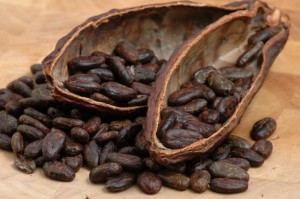Dinner
by connorwilson ~ July 26th, 2012. Filed under: Dinner, Food Log.→ Cucumber Salad, Cordon Bleu, Veil Schnitzel, Mashed potatoes, Chocolate Cake
Just after I finished eating I began to brainstorm the oil consumption that could be traced in my dinner, and let me say it was difficult. My girlfriend’s grandparents who had prepared this meal for us had picked up the meats and vegetables locally from the farmers market just hours before preparing dinner, and even the chocolate cake was make out of home crafted chocolate! At first I thought well this would be a boring post, because everything was slaughtered just minutes from here or grown just miles away… Until it struck me Cocoa (chocolate) is from no where even close to Romania, and is a commodity that has some controversial ties along with it ( child slavery etc.) that could make this very interesting. And interesting it was..
Cocoa is grown from the seed of the tropical Theobroma cacao tree and has been cultivated for at least three millennia in Mexico, Central and South America and Africa. For this articles sake I will follow the consumption of oil in a regular chocolate bar and not one that was hand crafted from cocoa beans (similar to what I had).
The process begins in the Cocoa fields, where workers harvest the cocoa pods and scoop out of the pod anywhere between 50 and 100 cocoa beans along with a gelatin substance that helps the cocoa to ferment. After the fermentation process is complete, the beans are separated from the gelatin substance and left out to dry either at the farm or at a processing plant. The dry beans are then collected and labeled raw cocoa and are shipped in the thousands of kilograms to chocolate manufacturers. At this point of the production process cocoa undergoes little oil consumption (if the drying process was done at the farm), but like all other foreign agricultural goods, the oil used in shipping is what makes the largest contribution. The cocoa bean is usually transported via ship, in large containers. And as we saw before in the Wheat Section, vessel oil consumption is anything but “efficient”.
Upon the cocoa arriving at the chocolate facility, it is tested them immediately put in to production. The first step in the chocolate making process is the blending of mixed beans to create the perfect flavors. The beans are then put in to large cylinders and roasted (via flame) for around two hours. This roasting process again requires large amounts of petroleum. After roasting, the cocoa is stripped of its shell and then crushed in to liquid by large steel grinding stones, and from here is either put under immense pressure to produce cocoa powder or left as cocoa liquid.
Shortly after some fine-tuning to the cocoa, it is then packaged and shipped to chocolate bar producers or distribution centers that sell the raw cocoa products.
In just my short description of the cocoa process, the amount of oil used in the transportation of the beans, and the milling of the beans is one that requires immense amounts of oil. At first I thought cocoa was simply harvested and then crushed to make the powder, and not refined many times to get the product we enjoy around the world. If you want to see more about this process watch this movie here– it goes behind the scenes in the process I explained above and gives much better insight than I ever could have.
Aside from my cocoa research, the amount of oil used in my dinner was very scarce. Other than the petrol used to transport the items from the farm to the market, no real intermediate products existed. There was milk in the potatoes, and salt and pepper on the meats, and home made breadcrumbs on the veil, all of which were home made from produce and products just minutes away.

